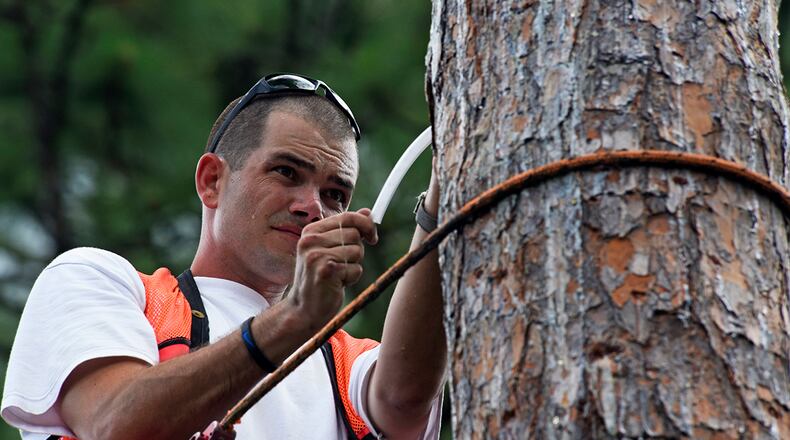Through a combination of programs and partnerships with installations and the U.S. Fish and Wildlife Service, AFCEC is helping some endangered species make a comeback. Air Force installations are home to 123 of the more than 2,000 species on the Fish and Wildlife Service’s endangered species list. The habitats range over nine million acres across 54 installations, said Kevin Porteck, AFCEC’s Natural Resources Program manager.
“The environmental projects we fund help cultivate population growth, which allows more flexibility for the Air Force mission,” Porteck said. “Our ranges are home to a diversity of wildlife, and these installations can become the last refuge for some of these species when surrounded by urban development.”
For example, the Okaloosa darter fish resides primarily on Eglin AFB, one the Air Force’s largest and most active test and training areas. The U.S. Fish and Wildlife Service placed the darter on the endangered species list in 1973 after sediment from unpaved roads and uncontrolled soil erosion affected stream water quality.
“We’ve been implementing best management practices for managing erosion and have the benefit of full-time advisors from the U.S. Fish and Wildlife Service to guide us through the management of the species,” said Bruce Hagedorn, 96th Civil Engineer Group Natural Resources Branch chief.
Eglin’s partnership with USFWS and AFCEC helped the installation develop an integrated natural resources management plan that ensures the Air Force complies with environmental protection laws during test and training missions. The plan supports programming, budgeting and the execution of natural resources requirements including projects that conserve endangered species and provide a safe habitat, Porteck said.
Because of those efforts, the Okaloosa darter was reclassified from endangered to threatened in 2011, making it the first fish to be reclassified on Department of Defense land. The Air Force hopes that the species can be recovered to the point of being delisted in the near future.
“We want the world to know, the Air Force is a proud steward of its environment and we are thrilled to partner with countless others to help recover and take species at risk such as the darter off the threatened and endangered list,” Porteck said.
The red-cockaded woodpecker also ranges across the vast Eglin training ranges, and AFCEC’s Air Force Wildland Fire Branch is using prescribed burns to protect its habitat. Overgrown vegetation adds fuel to the ecosystem, which intensifies fires and increases the risk of destruction to important natural habitats, said Michelle Steinman, Wildland Fire Branch chief.
The woodpecker was listed as an endangered species in 1970. Through a combination of conservation practices and controlled burns across nearly 140,000 acres of habitat, the partnership between AFCEC and the installation has helped increase woodpecker potential breeding pairs. The woodpecker population has increased 42% from 1994 to 2001, and Eglin achieved a goal of 350 potential breeding groups in 2009.
Recovery of the woodpecker on the installation has led to increased mission flexibility and has allowed Eglin to donate woodpeckers to other populations striving for recovery. The U.S. Fish and Wildlife Service is considering these positive trends in its assessment of the status of the species to either remain endangered, downlisted to threatened, or delisted, Porteck said.
For Lee, the power of partnership between installations, AFCEC and USFWS is demonstrated when sea turtles nest at Eglin each year beginning in May. The base invites the public for a couple of sea turtle hatchling releases, and the team also tags adult turtles with acoustic and satellite tags to track which areas to avoid during gulf missions.
“I love being a part of initiatives such as the sea turtle nesting project because we are all coming together to protect these animals and truly making a difference,” Lee said.
About the Author
